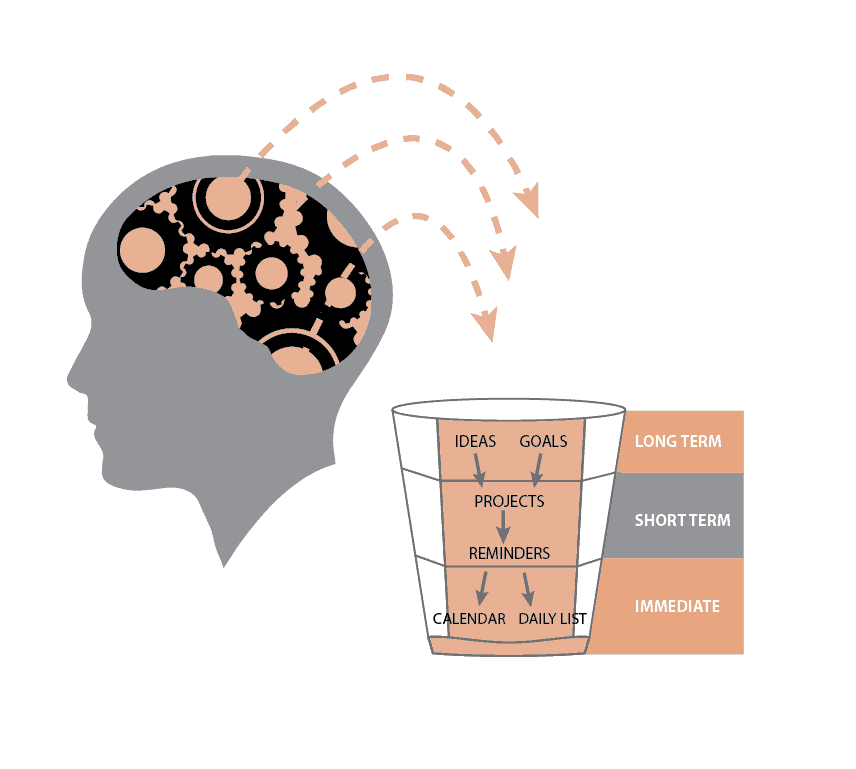
Task management is about capturing your priorities, sorting them into a tool you trust, and tracking them until they are complete
By capturing, sorting and tracking all the important ideas and to-dos that crop up every day we’re able to achieve goals and progress towards the life that we want.
Hand in Hand
It’s important to understand the system that enables the framework that these tools hang off of. This understanding needs to happen before we launch into the tools that you need to do the capturing, sorting and tracking effectively.
I say this because often I work with people who have tried every tool and every hot new app ever created. They’ve sometimes had more experience with some of the tools than me! I admit I learn a lot about new software and apps from these clients but they really didn’t need to bother with all that. I see that they’re attempting to find the perfect tool that will make their mental clutter evaporate and become magically organised. Unfortunately, they find that it doesn’t happen. It’s not the tool itself that is the magic trick. But how you use the tools. Your tools have to become part of the larger context of your system for everything to click. The system is what makes the tool work. Not the other way around. Google Calendar doesn’t know that you have to submit an application in time for a deadline. You have to be aware of the deadline and put it into the Calendar for the reminder to work.
Here’s an image I share with clients to help them visualise the kind of framework that we’re aiming for:
 Some clients don’t need all these components. Others do. Have a think, what parts of this framework are already active in your life?
Some clients don’t need all these components. Others do. Have a think, what parts of this framework are already active in your life?
The Difference
Not all ideas and tasks are equal in weight.
Long term ideas: these are the daydreams, the sparks of inspiration. These don’t have commitment attached to them yet. Maybe it’s a list of travel places. Or the premise for the book you want to write one day. Or a business idea to patent.
Long term work/life goals: these are the goals that you are working toward in your personal and professional life. They usually have a specific time-frame attached.
Short term projects: these are the multiple tasks, deadlines, and responsibilities of a particular project that you have on the go. Where you store and break them down into their milestones.
Short term reminders: The things you need to complete in the short-term, but not today.
Daily List: immediate, you’re committed to completing these today.
Calendar: appointments, tasks and deadlines that have a specific time attached.
Once you get clear on the framework, you need to assess what tools to use to complement it. By sorting out your tasks and ideas into these categories, you are making it much easier on your brain to prioritise, delegate and accomplish what you need to do each and every day.
What tools are you using already to capture all your reminders and to-dos?
For an example, I use:
- Post It notes
- Emails
- Apps on my phone (synched to my desktop)
- Voice notes
- Text messages
Some clients train themselves to cut down on the number of ways they are capturing things. Others train themselves to use more than just their memory!
For many people, there’s a difference between the tools used to capture tasks and the tools used to store the tasks and upcoming action steps. You can use your calendar as your capture tool but it takes some training to ensure that you immediately schedule a task into the appropriate time slot.
This is how my prioritised tasks are stored:
- Long Term Tasks and Long term work/life goals: OneNote
- Short Term Projects and Short term reminders: Keep Notes for personal and Toodledo for work
- Daily List and Calendar: Google Calendar
My own system is merely an example, I’ve seen so many different combinations over my time of working with clients. It truly is a personal preference.
Everything Out!
As David Allen in his book Getting It Done says: Your brain is made for having great ideas, not holding them. When you’re depending on your memory to track your priorities, your chances of becoming overwhelmed are huge. Many of my clients come to me with a lot of tasks, ideas, reminders, appointments, birthdays, wants, needs, desires, projects, deadlines, swirling around in their mind. Throw on top all the new stuff that comes in daily from email, meetings, family, friends, new clients, advertisements, house maintenance things – it’s a mess!
Your brain doesn’t know which thought is more important, you decide that. Have you ever been to a yoga class (or something similar where you can’t access paper and pen) and remembered two things you need to buy and had one great idea? Maybe you try to remember them all. But knowing that the great idea is more valuable, that’s the one you keep recalling, again and again, to make sure it sticks. Your brain thinks they are all equal so without you directing your efforts towards remembering the most important thought, they could all disappear. So how do you make sure none of these priorities fall through the cracks?
Capture them! Really get that task management system working.
One of my client’s testimonial sums up the process of going from no system to feeling in control really well:
I am a mum who runs my own business and I was really struggling to keep on top of the juggle. I was writing notes on scraps of paper, running multiple notebooks for different tasks and feeling completely scattered. I was also wasting precious time trying to find importation information and remember where everything was. After just a few hours with Christie, I already feel so much more in control of my to-do list. We have set up a really simple system for getting all my thoughts down, then transferring to short, medium and long-term goals. It feels completely achievable and SO much easier than what I was doing.
Next Steps
So now we know what elements come together to form a task management framework (the ideas themselves, the capturing tools, and tools to determine what will be actioned).
The next step is to get into the habit of capturing as many ideas and tasks as possible. When you start to feel overwhelmed, use that as a trigger to empty your mind and get everything into your system.
Take time to shape your Task Management framework and notice what’s working and what’s not. Getting to know and tweaking your framework is the way to make it suit your unique needs so you get all the benefits.

Talk soon,
Christie








